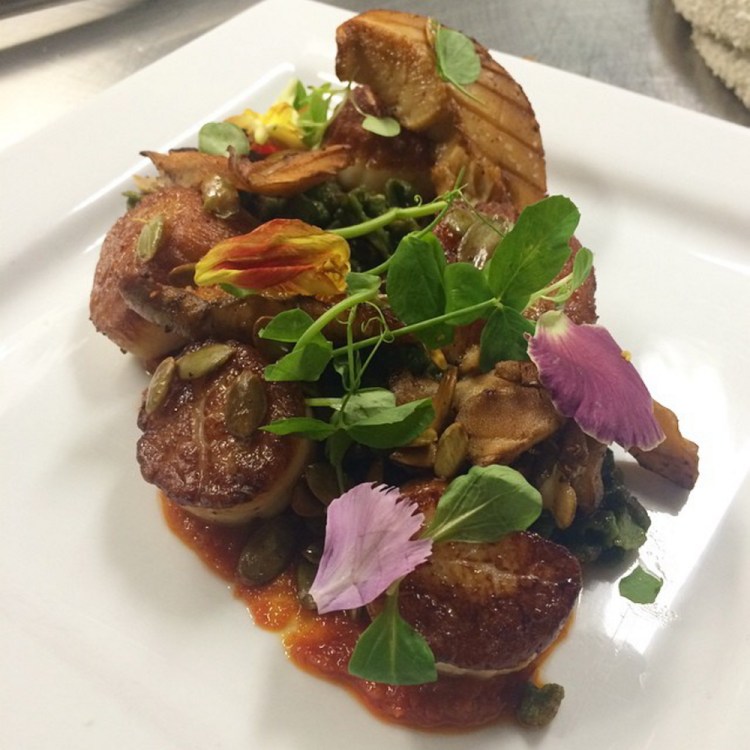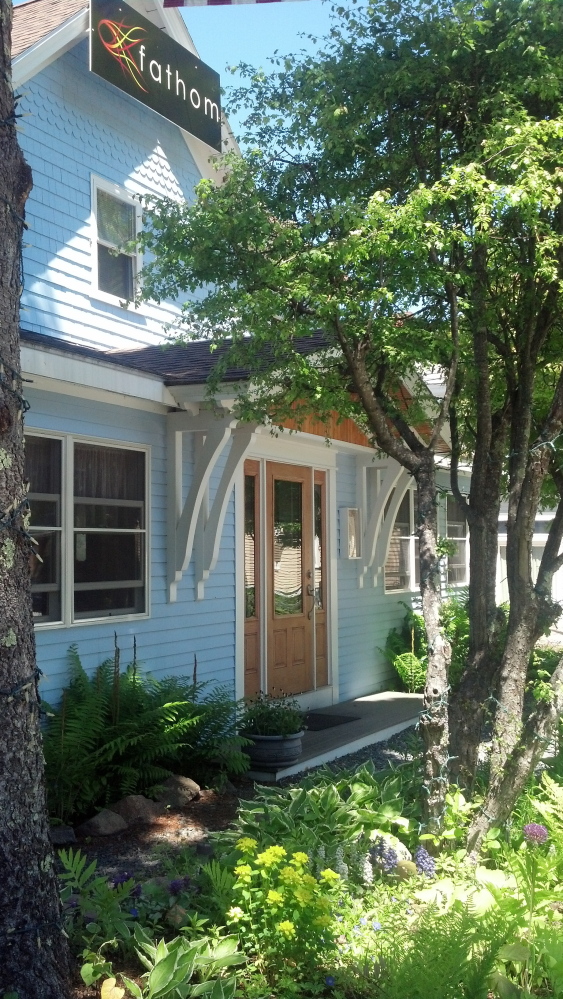Ahhh, the power of restraint. Fresh ingredients prepared simply and consistently are the hallmarks of many unforgettable meals. And they’re characteristics that the kitchen staff at Fathom, an appealing cottage-like restaurant on a side street in Bar Harbor, would do well to remember.
The restaurant occupies the first floor of a brightly painted frame house at the edge of downtown. Inside, it’s a soothing space with pastel walls, subdued lighting and quiet music. The tables are small, the waitresses smile, and the atmosphere is relaxed and elegant. There’s a covered, well-heated outdoor patio strung with a few strands of white lights, and at a bar in the corner, regulars are joking with the bartender.
Seated comfortably at a corner table one night last month, a friend and I scanned the menu, taking note of the contemporary American cuisine and the many appetizers and entrees drawn from the sea. (The restaurant is called Fathom, after all.) Chef Bobby Will, a CIA (Culinary Institute of America) graduate who grew up in New England and has worked at restaurants on Block Island and near Boston, also has a keen interest in local produce; it was evident in such items as apples (used for chutney), squash, rainbow chard, wild mushrooms – all sourced locally.
The prices seemed somewhat high (entrees range between $19 and $32), but Bar Harbor is a tourist mecca, after all, and upscale Fathom caters largely to a crowd “from away.” (To cultivate local support, the restaurant does offer people who work on the island a 20 percent discount on Wednesdays.)
The waitress returned with a brief rundown of daily specials. At the mention of seared sea scallops ($26), I put the menu down and smiled. Perfect! But – mea culpa – I should have listened more carefully. Those scallops, I learned later to my dismay, came with a mind-numbing collection of sides: a bed of spinach spaetzle (German dumplings oddly described here as “free-form pasta”), a purée of sun-dried tomatoes, a scattering of “locally foraged mushrooms,” roasted pumpkin seeds, fresh cress and pea shoots. The cacophony of ingredients should have been a tip-off. Still, the thought of those scallops …. You’ll see how they worked out, but let’s start at the very beginning.
The waitress suggested a warming bowl of fish chowder, which sounded ideal on a chilly night. Pleasingly oily swordfish and meaty halibut might have made for a substantial, deeply-flavored soup. But not this evening – the broth was bland, and the fish chunks disappeared among the potato cubes and bacon crumbles. Fortunately, our disappointment was tempered by the arrival of a salad that proved to be a delicious, tart surprise: simply dressed greens and endive, a scattering of poached pears and a few brilliant red morsels of local beets. Complicated? Not at all. But that was the point. Nothing detracted from the flavors of the fruit and the pleasant crunch of the vegetables. The straightforward citrus vinaigrette tasted clean and refreshing.
My quintet of beautiful scallops arrived next. Plump and briny, they were impeccably seared with salty brown exteriors and sweet creamy centers that carried a taste of the ocean and a heady whiff of the sea. Someone at the stove knew what he was doing. But the rest? The spaetzle and puree? The pumpkin seeds and cress? Those locally foraged mushrooms? The pea shoots, for goodness sake? Distractions. Competing, confusing, unnecessary distractions. And pricey distractions at $26.
Contrast this over-produced entrée with the filet of beef, a center cut from the tenderloin served over whipped potatoes and a mountain of crispy kale. My friend requested it medium well and the kitchen complied. Medium well can skid rapidly toward dry and tasteless, but this beef remained tender and juicy with the slightest hint of pink. It was hearty and substantial – a lovely counterpoint to flash-fried kale so light it practically hovered over the plate, each leaf crackling and melting on the tongue like a fragile flower of salt. All this dish needed was a generous grind of fresh black pepper and a glass of Liberty School Cabernet Sauvignon ($9) from Paso Robles.
So you’re wondering about dessert, right? So were we. Feeling, by now, like experienced hands, we thought we’d play to Fathom’s strengths and order something unadorned. Therefore crème brûlée, a safe and smart choice that our waitress noted was a perennial favorite. Unfortunately, here too, the kitchen gilded the lily – or the flower that came on top of the ramekin delivered to the table with two spoons. We rapped the top of the dessert, eager to dig into the custard below. Nothing happened. Another attempt. Nada. Feeling like the VIP who failed to break the champagne on the bow of the ship, I resorted to force, smashing through a dense crust into a pool of pudding laced with amaretto. The custard was sweet and the shards of the crackly, burnt-sugar top pleasantly bitter, but the kitchen seemed to have lost its way in a muddle of liqueur and an overly enthusiastic helping of sugar.
The experience begs the question: Is Fathom worth a try?
Depends on what you’re looking for. The restaurant has an enviable location: close enough to the main roads in and out of Bar Harbor that traffic (even when cruise ships are in port) poses no problem, but far enough from the main shopping area to feel part of a neighborhood. The frequently changing menu accommodates many different tastes and dietary concerns. Last month, we had our choice of vegan risotto with beets, Swiss chard and grilled tofu ($19); seared duck breast ($26); three fish entrees ($26-$32); grilled lamb chops ($30); and lobster in broth ($32). The service is exemplary – patient and professional.
But then there’s the cooking, which careers between diligent and precise and, frankly, sloppy. Even diners with deep pockets – or especially diners with deep pockets – should expect more.
If you’re searching for pleasant service in an attractive setting on Mount Desert, book a table at Fathom. If, on the other hand, you’re looking for consistently well-prepared food with a reliable wow factor, restrain yourself. Fathom’s execution is uneven and the kitchen staff – however ambitious – may just be out of their depth.
James H. Schwartz has covered food, travel and architecture for The Washington Post, Downeast, Coastal Living and Southern Living magazines for more than 30 years. Long a commuter between Portland and Washington, D.C., he retired from his job as vice president at the National Trust for Historic Preservation in 2013 and relocated to Maine.
Send questions/comments to the editors.




Success. Please wait for the page to reload. If the page does not reload within 5 seconds, please refresh the page.
Enter your email and password to access comments.
Hi, to comment on stories you must . This profile is in addition to your subscription and website login.
Already have a commenting profile? .
Invalid username/password.
Please check your email to confirm and complete your registration.
Only subscribers are eligible to post comments. Please subscribe or login first for digital access. Here’s why.
Use the form below to reset your password. When you've submitted your account email, we will send an email with a reset code.